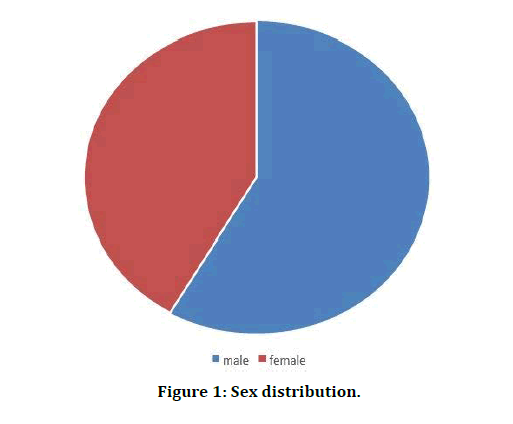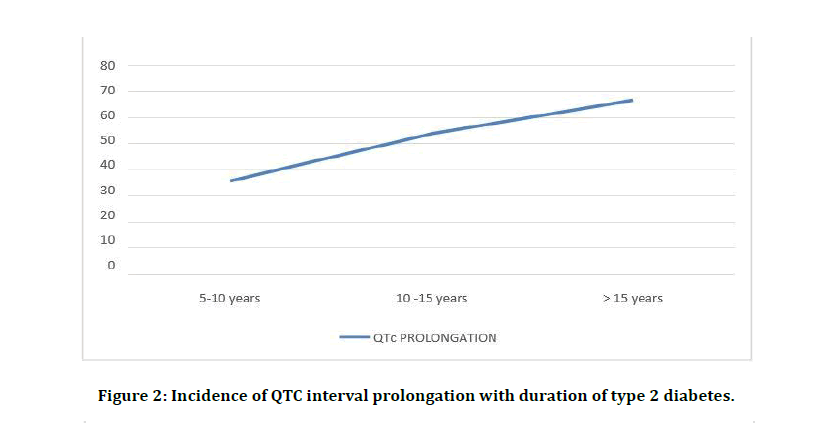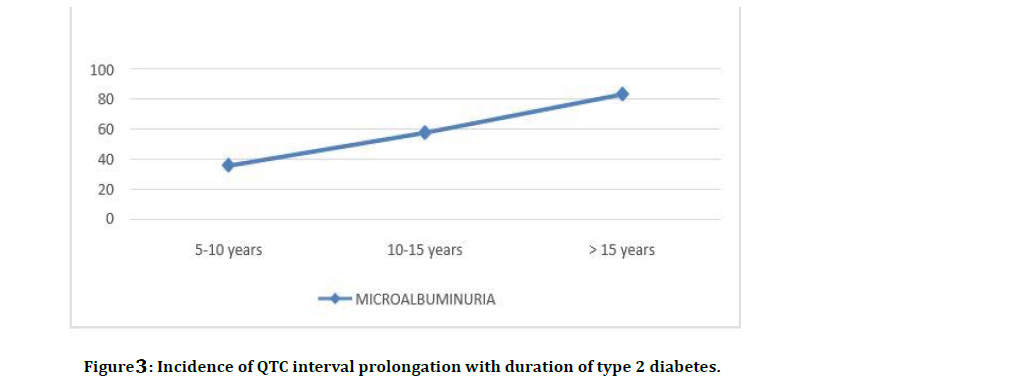Research - (2021) Volume 9, Issue 5
Association Between Prolonged QTc Interval and Microalbuminuria in Patients of Type II Diabetes Mellitus
S Sakthi Selva Kumar, S Palaniandavan and V Padma*
*Correspondence: V Padma, Department of General Medicine, Sree Balaji Medical College and Hospital Affiliated to Bharath Institute of Higher Education and Research, Chennai, Tamil Nadu, India, Email:
Abstract
Objectives: This study was done to find the association between QTc interval prolongation and microalbuminuria in patients of type II diabetes mellitus.
Methods: This cross-sectional study was conducted in SREE BALAJI MEDICAL COLLEGE AND HOSPITAL with 60patients of type 2 diabetes mellitus. A complete History and thorough clinical examination were recorded in these patients at the time of admission.
Results: Most of the patients were in 50 to 70 years of age group. There is a significant association between QTc interval prolongation and microalbuminuria as evidenced by a greater number of cases with microalbuminuria having prolonged QTc interval (67.76% Vs 24.13%, P<0.0001). Male to female ratio is 1.15:1.
Conclusion: There was a significant association between cardiac autonomic neuropathy (i.e. QTc interval prolongation) and microalbuminuria. Microalbuminuria doesn’t directly cause QTc interval prolongation, but it can be used as an indicator for patients who are prone to develop cardiac autonomic neuropathy and hence are at higher risk of having fatal arrhythmias.
Keywords
QTc interval prolongation, Microalbuminuria, Cardiac autonomic neuropathy, Diabetic nephropathy
Introduction
India is the diabetic capital of the world. Diabetes is rapidly gaining the status of a potential epidemic in India with more than 62 million [1] individuals currently diagnosed with the disease. Most of the diabetic population is undiagnosed and even those who are diagnosed are not receiving proper treatment. People with diabetes have an increased risk of developing a number of serious complications including cardiovascular diseases, nephropathy, neuropathy and retinopathy etc. Diabetic neuropathy is one of the most common among the complications of diabetes. Yet, it is the least investigated and has a poorly understood pathogenesis. Diabetic nephropathy is a leading cause of diabetes related mortality and morbidity. Microalbuminuria is an early marker of glomerular diseases that has been shown to predict glomerular injury in early diabetic nephropathy [2].
It has been demonstrated that cardiac dysfunction can occur in diabetic patients without any evidence of ischemic heart disease, caused by Cardiac Autonomic Neuropathy (CAN) and this increases the risk of sudden unexpected death [3,4]. Prolonged QTc interval is found to be a specific indicator for CAN. For all cardiovascular mortality in type 2 diabetes, QTcmax was found to be an independent predictor. By virtue of early detection and therapeutic interventions such as physical training, weight loss, anti-hypertensives, and beta blockade the delirious effects of CAN might be reduced [5].
In type 1 diabetics, QTc interval abnormalities have been shown to be associated with microalbuminuria indicating the relation between Cardiac Autonomic Neuropathy and diabetic nephropathy [6]. But there are very few such reports in type 2 diabetes. The aim of this study is to evaluate CAN, as predicted by prolonged QTc interval and to check its association with microalbuminuria in type 2 diabetic patients and correlate it to the severity and duration of diabetes.
Methodology
60 patients of type 2 Diabetes Mellitus attending Sree Balaji medical college and Hospital and were studied over a period of one year (January 2015 -January 2016). The study subjects are those who fulfill the inclusion and exclusion criteria.
Inclusion criteria
All type 2 DM patients attending Sree Balaji medical college and Hospital over a period of one year.
Exclusion criteria
✓ History of MI/Angina.
✓ Clinical evidence of heart failure.
✓ Left bundle branch block.
✓ Atrial fibrillation.
✓ Uncontrolled hypertension (>180/100 mm of Hg).
✓ Febrile illness / Urinary tract infection.
✓ H/o drug intake like ACE/ARB’s/NSAIDS.
✓ Acute poor metabolic control.
✓ Smoking.
✓ High serum calcium levels.
From the selected patients detailed history was obtained and a thorough physical examination was done. History including age, sex, age of onset and duration of diabetes and details regarding presenting complaints were noted. Past history of any other disease is noted, the total duration of diabetes, drugs taken by the patients, regularity and dosage was also noted. A family history was taken. Personal history like smoking, alcohol consumption, drug intake was noted. Then, a complete clinical examination is carried out in each patient with reference to complications of diabetes.
The following investigations are done in these patients:
✓ CBC.
✓ FBS, PPBS.
✓ Blood urea, Serum creatinine.
✓ Urine routine and microscopy.
✓ Test to detect microalbuminuria (MICRAL test).
✓ ECG (To calculate QTc interval- Average of 3 QT and RR intervals from the leads where QT interval is easily identified to calculate this by BAZZET’s.
✓ Formula- QT / √RRms).
✓ Special investigations if required.
Sample size
60 cases of type 2 diabetes mellitus patients. In a study11 out of 86 patients (43 microalbuminuric, 43 normoalbuminuric) the proportion of patients with prolonged QTc interval was 67% in microalbuminuric and 38% in normoalbuminuric type 2 patients. Using this as a reference, 2 samples were made of 30 each and sample proportion is calculated.
Statistical analysis
Chi-square test.
Results
Age and sex distribution
Most of the patients selected were between 50 to 70 years of age (Table 1 and Figure 1).

Figure 1: Sex distribution.
Table 1: Age distribution.
| Age (Years) | No. of Cases | Percentage |
|---|---|---|
| 50-59 | 26 | 43.33 |
| 60-69 | 22 | 36.66 |
| 70-79 | 7 | 11.66 |
| >80 | 5 | 8.33 |
| Total | 60 | 100 |
Out of 60 cases, 28 cases (46.67%) have QTc interval prolongation. Out of 31 cases with microalbuminuria, 21 cases had QTc interval prolongation (67.76%). Out of 29 cases with normoalbuminuria 7 had QTc interval prolongation (24.13%). This value (67.76% Vs 24.13%, P<0.001, HS) is statistically significant (Table 2).
Table 2: Association of QTC interval prolongation with microalbuminuria.
| CAN (QTC Interval Prolongation> 440 M sec) | |||
|---|---|---|---|
| Present | Absent | Total | |
| Microalbuminuria | 21(67.76%) | 10(32.24%) | 31(100%) |
| Normoalbuminuria | 7(24.13%) | 22(75.86%) | 29(100%) |
| Total | 28(46.67%) | 32(53.33%) | 60(100%) |
As the duration of diabetes increases, incidence of CAN (QTc prolongation) increases. In 5-10 years, it is 35.72%, 10-15 years it is 53.85% and in 15-20 years it is 66.67% (Figure 2).

Figure 2: Incidence of QTC interval prolongation with duration of type 2 diabetes.
Mean duration of diabetes with microalbuminuria is 11.18 years. As the duration of diabetes increases, there is increased incidence of microalbuminuria. In 5-10 years duration, it is 40.65%, in 10-15 years duration it is 54.54% and in more than 15 years duration it is 83.33% (Figure 3).

Figure 3: Incidence of QTC interval prolongation with duration of type 2 diabetes.
Discussion
CAN is a frequent and life-threatening complication of type 2 DM. Failure to recognize this leads to high mortality and morbidity. Studies [7,8] have shown that prolonged QTc interval is an indicator of cardiac autonomic neuropathy. This is a simple, quick and non-invasive test for CAN. Many studies have also proven that diabetic nephropathy can be predicted by microalbuminuria. In our study we are finding the association between CAN (QTc interval prolongation) and nephropathy (microalbuminuria) in type 2 Diabetes Mellitus [9,10].
In a study by Rutter et al. [11] on the association between QTc interval prolongation and microalbuminuria in patients with type 2 diabetes mellitus, the proportion of microalbuminuric patients with QTc interval max (>440 msec) is 67% Vs 38% (p=0.01) which is statistically significant [12]. In our study the proportion is 67.76% Vs 24.13% (p<0.0001) which is highly significant. In a similar study conducted by Pappachan et al. [5] diabetic duration over 10 years resulted in significant QTc interval prolongation. In another study by Mohan et al. Sastry et al. [12-15], QTc interval prolongation in (0-5) years of diabetes is 28.2% which increases to 56.2% in (16-20) years. So our study correlates well with these studies.
In our study, sex ratio (M: F) in QTc interval prolongation (CAN) is 1.15:1 which is lower than or equal to the study by Mathur CP, et al. [7] and Khoharo, et al. [13] which are 1.38:1 and 1:1 respectively. Our study, age of onset of CAN correlates well with other similar studies. In our study, mean age of onset of cardiac autonomic neuropathy is 62.14 years as compared to the study by Khoharo et al14 and Pappachan et al. [5] which are 53.62±8.3 and 53 years, respectively. In several studies [6,9,15] there is association of CAN with neuropathy and retinopathy. In our study, out of 20 cases of peripheral neuropathy, 16 cases had QTc interval prolongation (CAN) accounting to 80%, which is significant and out of 19 cases of retinopathy, 14 cases had QTc interval prolongation (CAN) which accounts to 73.68%.
Conclusion
This study is done in 60 patients of type 2 diabetes mellitus. A detailed history of diabetic illness and diabetic complications including neuropathy and nephropathy was obtained from all the patients which was followed by a thorough physical examination. Evidence of CAN (QTc interval prolongation in ECG) and nephropathy in the form of microalbuminuria were noted. Higher age groups and patients with higher duration of diabetes, have increased risk of cardiac autonomic neuropathy. There is a significant association between prolongation of QTc interval and microalbuminuria in these patients as evidenced by a greater number of cases with microalbuminuria having prolonged QTc interval. Mean duration of diabetes in microalbuminuria is 11.82 years. As the duration of diabetes increases, prevalence of microalbuminuria also increases. 80% of patients with peripheral neuropathy and 73.68% of patients with retinopathy are associated with CAN. 65% of cases with neuropathy and 68.72% of cases with retinopathy are associated with microalbuminuria.
Funding
No funding sources.
Ethical approval: The study was approved by the Institutional Ethics Committee.
Conflict of Interest
The authors declare no conflict of interest.
Acknowledgements
The encouragement and support from Bharath University, Chennai, is gratefully acknowledged. For provided the laboratory facilities to carry out the research work.
References
- Kumar A, Goel MK, Jain RB, et al. India towards diabetes control: Key issues. Australas Med J 2013; 6:524–531.
- American Diabetes Association: Diabetic nephropathy (Position Statement). Diabetes Care 2000; 23:S69–S72.
- Ebbehoj E, Poulsen PL, Hansen KW, et al. Effects on heart rate variability of metoprolol supplementary to ongoing ace-inhibitor treatment in type diabetic patients with abnormal albuminuria. Diabetologia 2002; 45:965-975.
- Mohan V, Sastry NG, Premalatha G. Autonomic dysfunction in non-insulin dependent diabetes mellitus and fibro calculous pancreatic diabetes in South India. Diabetic Med 1996; 13:1038-1043.
- Pappachan JM, Sebastian J, Bino BC, et al. Cardiac autonomic neuropathy in diabetes mellitus: prevalence, risk factors and utility of corrected QT interval in the ECG for its diagnosis. Post Grad Med J 2008; 84:205-210.
- Mathur CP, Deepak Gupta. QTC interval prolongation in diabetes mellitus – An indicator of cardiac autonomic neuropathy. JIACM 2006; 7:130-132.
- Mehta S, Mathur D, Chaturvedi M, et al. Incidence of cardiac autonomic neuropathy and its correlation with retinopathy, micro-albuminuria and glycated hemoglobin in non-insulin dependent diabetes mellitus. J Indian Med Assoc 2002; 100:141-143.
- Tentolouris N, Katsilambros N, Papazachos G. Corrected QT interval in relation to the severity of diabetic autonomic neuropathy. Eur JClin Invest 1997; 27:1049-1054.
- Ewing DJ, Boland O, Neilson JMM, et al. Autonomic neuropathy, QT interval lengthening and unexpected deaths in male diabetic patients. Diabetalogia 1991; 34:182-185.
- Rutter MK, Viswanath S, McComb. QT prolongation in patients with type 2 diabetes and microalbuminuria. Clin Aut Res 2002; 12:366-372.
- Viswanathan V, Prasad D, Chamukuttan S. High prevalence and early onset of cardiac autonomic neuropathy among South Indian Type 2 diabetic patients with nephropathy. Diab Res Clin Pract 2000; 48:211-216.
- Kumar A, Goel MK, Jain RB, et al. India towards diabetes control: Key issues. Australas Med J 2013; 6:524–531.
- https://care.diabetesjournals.org/content/16/4/659
- Fernandez, Fernandez I. Rapid screening test evaluation for microalbuminuria in diabetes mellitus. Acta Diabetol 1998; 3594:199-202.
- Khoharo HK, and Qureshi F. Frequency of cardiac autonomic neuropathy in patients with type 2 diabetes mellitus reporting attaching hospial of Sindh. J Coll Physicians Surg Pak 2008; 18:781-784.
Author Info
S Sakthi Selva Kumar, S Palaniandavan and V Padma*
Department of General Medicine, Sree Balaji Medical College and Hospital Affiliated to Bharath Institute of Higher Education and Research, Chennai, Tamil Nadu, IndiaCitation: S Sakthi SelvaKumar, S Palaniandavan, V Padma, Association Between Prolonged QTc Interval and Microalbuminuria in Patients of Type II Diabetes Mellitus, J Res Med Dent Sci, 2021, 9 (5):170-174.
Received: 20-Mar-2021 Accepted: 19-May-2021 Published: 31-May-2021
